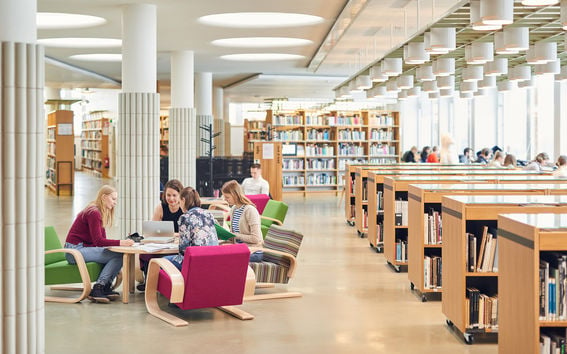Pinja Koskelin, studying for her master’s in interior architecture
‘A person with a Master of Arts degree can tailor the future in their own way.'

Interior architecture addresses the close human scale of space and furniture to create meaning and value to people and organisations, and to transform and renew the everyday living environment. Dealing with the design of immediate interior and exterior environments, interior architecture requires understanding on human culture, needs and aspirations, the bodily experience and senses, and the spatial, material and technological means to meet these. A skilled interior architect is capable of integrating diverse elements into functional and experiential design solutions that exceed the users’ and clients’ expectations and are socially, environmentally and economically sustainable.
The major educates interior architects with a distinct design personality. It comprises studies on spatial design and furniture design. Concrete design assignments form a major part of education. The studies emphasise advanced practical design skills combined with conceptual and strategic design thinking and research-driven design. Students are encouraged to expand the frontiers of the discipline by addressing systems level problems and societal challenges across the scale of built environment. Students graduated from the major are eligible to work as professional interior architects.
Content outcomes:
Students deepen the skills learned in bachelor's studies and broaden their knowledge in spatial design and furniture design. Students gain knowledge on:
Students learn to:
Students learn presentation skills in writing and visualisation.
In the major, the language of instruction is English.
The tuition fee for this programme is 20 000 euros per academic year. Citizens of European Union (EU), the European Economic Area (EEA) or Switzerland do not pay tuition fees. Citizens of other countries must pay tuition fees.
Aalto University offers a small number of scholarships in the form of tuition fee waivers to fee-paying students. Scholarships can be awarded to the highest-achieving applicants based on the programme's evaluation criteria. Applicants are ranked according to the criteria outlined on the programme's webpage.
More information on tuition fees and scholarships at Aalto University is available at the Scholarships and Tuition Fees webpage.
The master's major is based on an exploratory approach to design-based problem setting, elaboration and solving. It emphasises the skill to manage the entire design process from the beginning to the final outcome. An essential part of the education is project-based hands-on learning. In the projects, the students are encouraged to utilize artistic and experimental approaches and find their personal expression and voice as a designer. This is supported by more analytical, research-driven methods and tools.
The key content in master's major education is to develop and deepen the skills obtained during the bachelor's phase. Studio-based courses in spatial design and furniture design form the core of education. Other topics include history, theory and methodology of interior architecture and teaching of practical design skills and tools. The student can choose selective courses and a minor according to her interests and professional profile. In the final year, the student completes a master’s thesis on chosen topic.
The major consists of advanced studies (90 ECTS) and elective studies (30 ECTS)
More information on the content of the education can be found in the study guide under Curriculum.
Specialisation is built mainly through advanced studies, where students may choose courses.
Students are encouraged to apply for international exchange studies or internships. They are also encouraged to participate in international competitions, exhibitions, conferences, and trade fairs. The department has international research and teaching projects with different universities.
Graduates of the master's programme are eligible to apply for doctoral studies. More information on the Aalto Doctoral Programme in Arts, Design and Architecture: Doctoral programmes.
Career opportunities vary from entrepreneurship to expert tasks in private and public organisations. Graduates work as interior architects in design and architect studios, as independent entrepreneurs, and as in-house designers in industry. They also work as designers, managers, researchers and teachers, and engage in artistic practice. The major prepares its graduates also for doctoral studies.
Interior architects may focus on various areas, such as workspaces, retail spaces or care environments. Their tasks typically include spatial, surface, interior and lighting design in interior renovations and alterations. They also work on exhibition design and the design of other temporary structures, concept design, branding and corporate identity design, and design of furniture, lighting fixtures and other interior design components. Strategic, conceptual and managerial designer roles are increasingly common.
The research in this major is linked to several focus areas in the School of Arts, Design and Architecture. Additional information about research related to this programme can be found at the Department of Architecture website.
During the MA studies the students are introduced with the industry by having chances to co-operate with different types of companies in student projects integrated into the design courses.
Applicants meeting Aalto’s general eligibility criteria for master's studies will be evaluated and ranked according to the evaluation criteria that has been decided in advance for each study option. The applications to the Master's programme in Architecture, Landscape Architecture and Interior Architecture - Interior Architecture will be evaluated based on the following:
Phase I
| Academic performance | |
| What is evaluated | Grades of the previous degree(s) |
| What we look for in an applicant/Admission requirements | Earlier BA-level studies in the field of Interior Architecture, Architecture and/or Spatial and Furniture design. |
| Method of demonstrating competence | Transcript(s) of records, degree certificate(s) |
| Artistic and/or design practice | |
| What is evaluated |
Demonstrations of artistic and/or design work |
| What we look for in an applicant/Admission requirements | Professionality, artistic originality, capability to critical and conceptual thinking |
| Method of demonstrating competence |
Portfolio Maximum size for the portfolio is 1.0 GB. Name the file as: Portfolio-surname-firstname.pdf |
| Relevance of previous studies | |
| What is evaluated | Content and quantity in relation to the applied study-option-specific requirements |
| What we look for in an applicant/Admission requirements |
Earlier BA-level studies in the field of Interior Architecture, Architecture and/or Spatial and Furniture design. |
| Method of demonstrating competence |
Transcript(s) of records, degree certificate(s) |
| Suitability | |
| What is evaluated | Applicant’s further suitability to the study option, motivation, and commitment for studies/communication skills |
| What we look for in an applicant/Admission requirements | Motivation letter that conveys applicants motivation for applying for Interior Architecture programme. The applicant can describe his/her strengths and interests, visions in art and design, as well as design, and creative goals. |
| Method of demonstrating competence |
Motivation letter |
| Other areas of competence | |
| What is evaluated | Work experience and other acquired knowledge/achievements e.g. publications, non-formal education, competitions |
| What we look for in an applicant/Admission requirements | CV including personal data, educational background, work experience, exhibitions, publications and articles, awards and grants, study trips and positions of trust. |
| Method of demonstrating competence | Curriculum vitae |
Phase II
| Suitability | |
| What is evaluated | Applicant’s further suitability to the study option, motivation, and commitment for studies/communication skills/ interview in the second phase |
| Method of demonstrating competence |
Interview |
The applicants are first evaluated based on Aalto’s general eligibility requirements. Applicants meeting the general eligibility criteria for master's studies will be evaluated and ranked according to the evaluation criteria that has been decided in advance for each study option.
The selection process for applicants who meet the general eligibility criteria comprises of two phases:
Phase I
In Phase I, the applicants are evaluated based on the following criteria
Phase II
In Phase II, the evaluation is based on the following criteria
After the evaluation conducted in Phase II, the best applicants will be selected based on the joint evaluation from Phases I and II.
The documents required from all applicants are listed on the Aalto University website (https://www.aalto.fi/en/study-at-aalto/applying-to-masters-programmes). In addition, applicants to this study-option are required to provide the following study-option-specific documents:
Attach each of the following application documents to the electronic application form in PDF format:
Portfolio
In the portfolio, applicants display work that shows their artistic expression and design skills. The portfolio must contain diverse samples of the applicant’s previous artistic, professional and/or scientific activity.
The work contained in the portfolio must be catalogued, listing at least the title and/or theme, materials used, size, purpose and year of completion of each piece. The catalogue must also detail where and when the work has been exhibited, displayed or published and whether the work is based on individual or group work. The contribution of the applicant in the work should be stated in case the work has been completed in a group. The applicant’s name, address and phone number and the degree program applied for must be indicated clearly on the portfolio.
Maximum size for the portfolio is 1.0 GB. Name the file as: Portfolio-surname-firstname.pdf
CV
The application must include the applicant’s CV with personal data, educational background, work experience, exhibitions, publications and articles, awards and grants, study trips and positions of trust. No links.
Motivation letter
The applicant must convey his/her motivation for applying for Interior Architecture programme by writing a motivation letter. The applicant can describe his/her strengths and interests, visions in art and design, as well as design, and creative goals. Motivation letter is maximum 4000 characters including empty spaces.
Language of application documents
All the application documents must be submitted in English.

‘A person with a Master of Arts degree can tailor the future in their own way.'

Sisustusarkkitehtuurin opiskelijat kehittivät käyttäjälähtöisiä tila- ja palvelukonsepteja Vantaan Koivukylän terveysasemalle.

Aalto University's master's students in interior design created the BB house design.
Learning Services at the School of Arts, Design and Architecture
For enquiries regarding programme-specific application documents or studies in the programme, please contact Aalto ARTS Learning Services
Admissions Services
For enquiries regarding the application process, obligatory application documents or English language proficiency, please contact Admissions Services